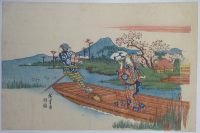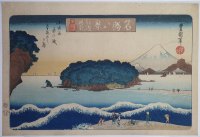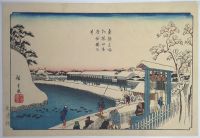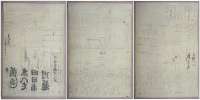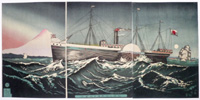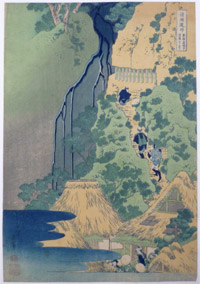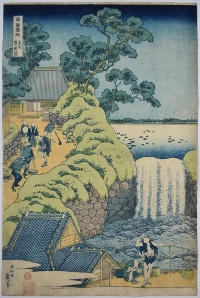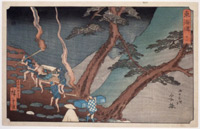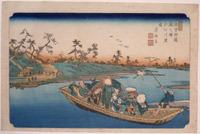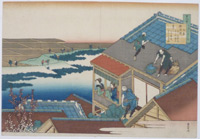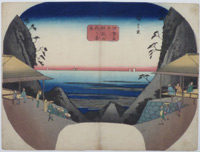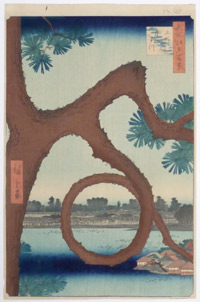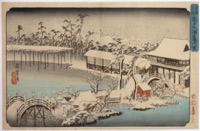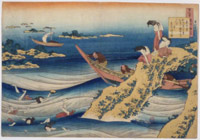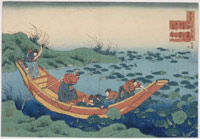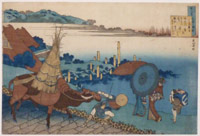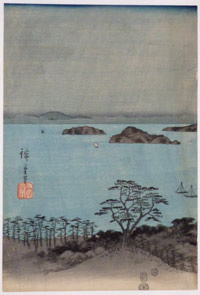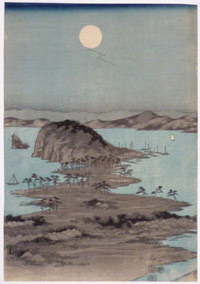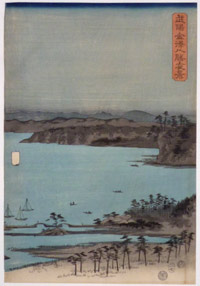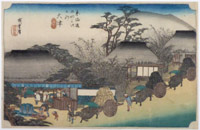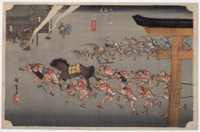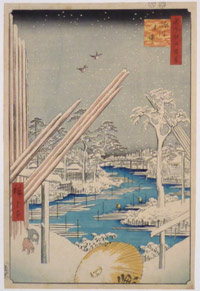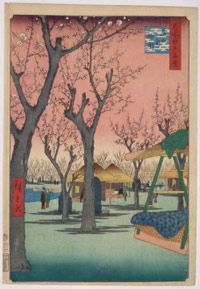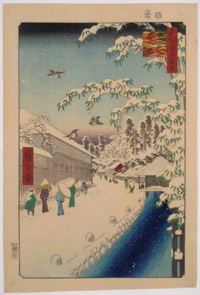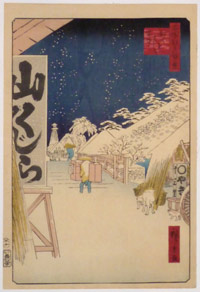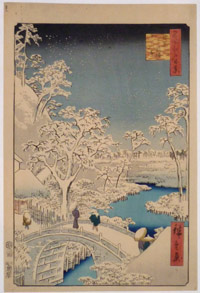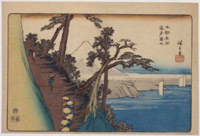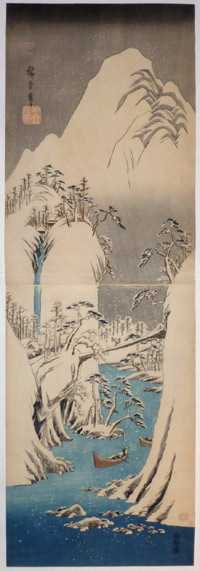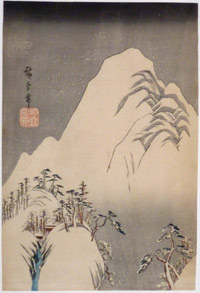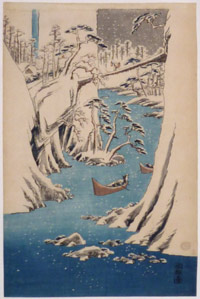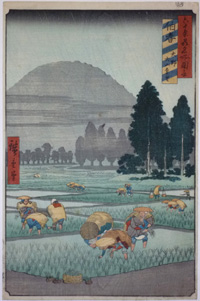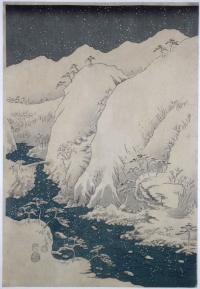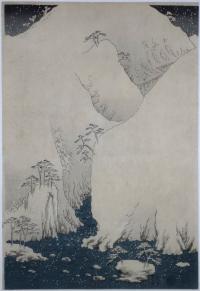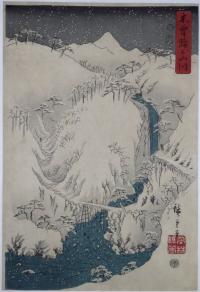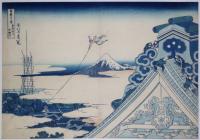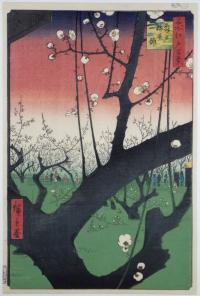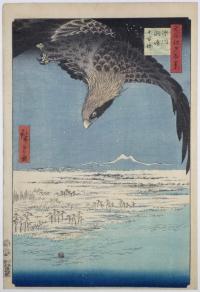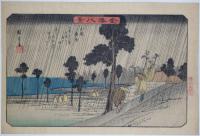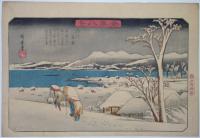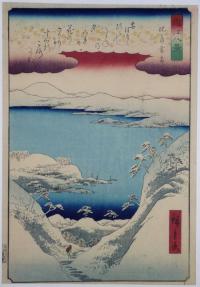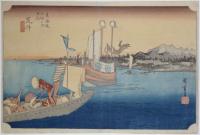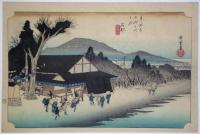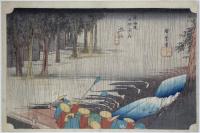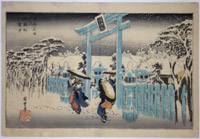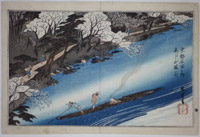Ichiryusai HIROSHIGE (1797-1858)
Click here to view image full size.
A woman ( Tomoe Gozen ? ) being poled down a river. From an extremely rare and early set of prints published by Marusei, c 1832-34. For three other designs from this set see Tamba, The Art of Hiroshige, nos. 131, 137, 138.
Fine impression and colour. Minor creasing, otherwise very good condition. Signed Hiroshige ga.
Status: Sold
Utagawa TOYOKUNI II (TOYOSHIGE) (1777-1835)
Click here to view image full size.
Clearing weather over the Enoshima Island from a Meisho hakkei, “Eight Views of Famous Places” ( based on the Eight Views of Omi theme ) set published 1830s by Iseri. A view of the island from Shichiri Beach in Sagami Province. The island was dedicated to Benten ( one of the seven gods of good luck ).
Fine impression. There are two states of this set: one with square and one with cursive script ( as here ) in the oblong cartouche at top. It is unclear which is the earliest. Fine impression. Small expert restoration to two upper corners, otherwise fine colour and condition. Signed Toyokuni hitsu.
Status: Sold
Ichiryusai HIROSHIGE (1797-1858)
Click here to view image full size.
Soto Sakurada Benkeibori sakura no i, “ The Cherry Tree Well in Snow at Benkei Moat, Sakurada” from a Toto meisho set published by Maruya Seijiro c 1843-45. The outer moat of Edo castle is named after Benkei Shozaeman who undertook the construction during the Kan’ei period ( 1624-1643 ).
Fine impression of the first edition with the Watari censor seal bottom left overprinted in blue and careful gradation above and below on the moat. Fine colour and condition. Signed Hiroshige ga.
Status: Sold
Ichiryusai HIROSHIGE (1797-1858)
Click here to view image full size.
A rare complete triptych hanshita-e (original drawing for a print). Presumably never published. A procession at Akasaka (?).
Signed Hiroshige ga on first sheet.
Status: Sold
Kobayashi KIYOCHIKA (1847-1915)
Click here to view image full size.
An extremely rare triptych: Sunshu Moho kokai chu no Fuji. Shows the paddle-steamer Daikokuya ploughing through the Sea of Miho, Suruga Province. The first rays of the sun hit the top of Mount Fuji. Kiyochika was an interesting artist: Although mainly self-taught, he also studied photography in Yokohama with Shimaoka Renjo and then the rudiments of western-style oil painting with the English correspondent, cartoonist, and painter Charles Wirgman. The influence of imported lithographs and etchings is evident in this print. Published by Matsuki Heikichi, 1878.
Very fine impression of the first edition with strong variegation in the sky, top left. Fine colour. Very slight trimming, otherwise very good condition. Signed Kobayashi Kiyochika hitsu.
Status: Sold
Katsushika HOKUSAI (1760-1849)
Click here to view image full size.
One of the most majestic landscape sets: Shokoku takimeguri, “Travelling Around the Waterfall Country.” A series of eight waterfalls, this being the Kiyo fall: Tokaido Sakanoshita, Kiyotaki Kannon, “The Kiyo Waterfall, Kannon Shrine at Sakanoshita on the Tokaido.” This fall descends in rivulets rather than a torrent. Shows pilgrims visiting the Kannon ( God of Mercy ) Buddhist cave to the right of the waterfall. Published by Eijudo, c 1832. Interestingly, there is a clever set of copies of this set, fully discussed in Oriental Art, Summer 1972, vol. XVIII, no. 2, pp. 141 – 147 by Roger Keyes.
Fine early impression. Fine colour. Very full size with only minor trimming top left: These designs are martyrs to trimming being slightly over-sized and few impressions are truly full size. Later impressions introduced a yellow-orange top right which spoils the harmony of the print, and the subtle gradation on the left is lost. Signed Zen Hokusai Iitsu hitsu.
Status: Sold
Katsushika HOKUSAI (1760-1849)
Click here to view image full size.
The Aoigaoka [waterfall] in Edo: Toto Aoigaoka no taki from a set of eight prints with title, Shokoku taki meguri, “A Journey to the Waterfalls of All the Provinces.” A majestic set with a mostly beautiful unifying colour scheme: There is probably no other Hokusai set that has the same impact when viewed complete. Amongst Hokusai’s finest work and much sought after. There are numerous Hiroshige designs based on the same location but they are prosaic in comparison. Eisen, inspired by Hokusai, also produced a set of waterfalls in 1847 which are themselves fine and rare. This particular fall is in fact a spillway for the Tameike reservoir seen above. Aoi Hill near Toranomon Gate to the left. The set published by Eijudo, c. 1832. Rare.
Fine impression. Fine, unfaded colour. Minimal soil and slight trimming on left: These designs are martyrs to trimming and many illustrated examples are trimmed, otherwise very good condition. (This raises an interesting problem because most Hokusai landscapes do not have a black border – contrary to Hiroshige’s – which do, making it easy to judge the trimming on the latter.) Signed Zen Hokusai Iitsu hitsu.
Status: Sold
Ichiryusai HIROSHIGE (1797-1858)
Click here to view image full size.
Hakone from the “Reisho” Tokaido. So-called because of the titles written in formal script. The best Tokaido set after the Hoeido. Shows travellers holding pine-torches climbing a mountain path at night. The Hakone mountains were one of the most gruelling parts of the Tokaido, but at the same time one of the most relaxing with the hot springs, Lake Ashi and the fine cryptomeria trees. Published by Marusei, c 1851-2. One of the five best designs from the set and probably the masterpiece. The composition and use of kimetsubishi to show the woodgrain in the night sky and mountains makes it one of Hiroshige’s most beautiful prints.
Fine impression. Fine colour and condition. Signed Hiroshige ga.
Status: Sold
Keisai EISEN (1790-1848)
Click here to view image full size.
Warabi, one of the Stations from Kisokaido rokujukyutsugi no uchi, “Sixty-Nine Stations of the Kisokaido.” The set of seventy prints was started by Eisen and published by Hoeido in 1835, but in 1837 Hiroshige took over and completed the set with the publisher Iseya Rihei ( Kinjudo ). Warabi no eki Todagawa watashi, “Warabi Station, Ferry on the Toda River.” Shows a ferry with a group of travellers: a pair of goze ( blind singers ); three males with hats; a horse and handler, and a porter smoking in the prow. The Station is seen on the far shore.
Very fine impression of the first edition with signature. Fine colour and condition. Signed Eisen ga.
Status: Sold
Katsushika HOKUSAI (1760-1849)
Click here to view image full size.
A poem by the Lady of Ise which speaks of a love that has not been reciprocated. From Hyakunin isshu uba ga etoki, the “Hundred Poems Explained by the Wet Nurse.” Published by Eijudo and Iseri, c.1835-6. Although obviously intended to be a set of 100 prints, only 27 are known plus drawings for others. The scene shows two ladies looking out over the rice fields to the Naniwa Inlet ( the ancient name for the region around Osaka ). The house is either being built or repaired with new tiles to the roof.
Exceptionally early impression with beautiful printing. This appears to be the earliest state with gradation on the roof bottom right and down from the top. Fine colour. Full size. Very slight centre fold, otherwise very good condition. Signed Zen Hokusai manji.
Status: Sold
Ichiryusai HIROSHIGE (1797-1858)
Click here to view image full size.
An uncut fan print from a set of views in Ise: Ise meisho, Asakumayama toge no chamise, “Teahouses on the Mount Asakuma Pass, Famous Places of Ise Province.” Hiroshige used this view about a decade later for his oban tata-e set The 60-Odd Provinces. He cleverly uses the cliff sides to wrap around the uchiwa-e shape. Published c. 1840. Extremely rare. This actual impression illustrated in Hiroshige no uchiwa-e, Unsodo 2010, p. 78, pl. 108. Ex collection Maroni, seal at bottom.
Fine impression and colour. Centre fold, as often, otherwise very good condition. Signed Hiroshige ga.
Status: Sold
Utagawa KUNISADA (1786-1865)
Click here to view image full size.
An apparently unrecorded horizontal diptych, each panel measuring 6.5 x 15 in; 16.5 x 38 cms. Two groups meet in a snowy landscape and the children, boys on left and girls on right, start a snowball battle. An early surimono-style design, published c 1826-7. Publisher unread ( Kagaya Kichibei ? ) A beautiful rarity.
Fine impression. Extremely good colour. Slight vertical folds, otherwise very good condition. Untrimmed, with ample space for joining. Signed Kunisada ga.
Status: Sold
Ichiryusai HIROSHIGE (1797-1858)
Click here to view image full size.
The Moon Pine, Ueno, Ueno sannai tsuki no matsu from Edo meisho hyakkei, “The Hundred Famous Views of Edo.” Published by Uoya Eikichi between Ansei 3 and 5 ( 1856 – 58 ), this design being Snake 8 ( 1857 ). Shows Shinobazu Pond, Ueno Park, seen through the ancient pine tree. ( also called the Rope Pine ).
Fine impression of the first edition. Trimmed close and slight fading. Signed Hiroshige ga.
Status: Sold
Ichiryusai HIROSHIGE (1797-1858)
Click here to view image full size.
The Kameido Shrine in snow. The best design from a Toto Meisho set of 21 prints published by Kikakudo ( Sanoki ) c. 1832-5 and then extended to 55 in c. 1839-42. The view shows the famous Drum Bridge, koi ponds and wisteria. The main shrine to the memory of Sugawara no Michizane ( Tenjin ), the father of Japanese learning, and built in 1662.
Fine impression. Probably the first edition with the cloak ( right figure ) and trousers ( left figure ) double printed, red over blue; crisp seal and red publisher’s seal in right margin ( later editions having the black seal of Sanoki ). These later editions have a black sky and a block defect appears at the edge of the pond centre left. Slight centre fold and shaved top right border, otherwise very good condition. Signed Hiroshige ga.
Status: Sold
Katsushika HOKUSAI (1760-1849)
Click here to view image full size.
A poem by Sanji Takamura from Hyakunin isshu uba ga etoki, the “Hundred Poems Explained by the Wet Nurse.” Published by Eijudo and Iseri, c.1835-6. Although obviously intended to be a set of 100 prints, only 27 are known plus drawings for others. The poem is a farewell on his exile to the Eighty Islands ( the Oki Islands, far out to sea, north of Honshu ). Hokusai shows his boat at the top of the design between the small islands. He instead concentrates on ama diving for awabi. These colourful girls were regarded as highly erotic as they dived bare-breasted. One of Hokusai’s most beautiful prints and, together with Minamoto no Muneyuki Ason, the best design in the set. Rare. Ex Le Veel collection , sold Paris 24/10/1980, lot 82. This impression exhibited and illustrated 10/1980 – 1/1981, Paris, Centre Culturel du Marais, Hokusai et son temps, p. 211, pl. 246.
Exceptionally early impression with beautiful gradation. Fine colour. Full size. ( The signature is often trimmed off because it is near right edge. ) Very slight centre fold, otherwise very good condition. Signed Zen Hokusai manji.
Status: Sold
Katsushika HOKUSAI (1760-1849)
Click here to view image full size.
A poem by Bunya no Asayasu from Hyakunin isshu uba ga etoki, the “Hundred Poems Explained by the Wet Nurse.” Published by Eijudo and Iseri, c.1835-6. Although obviously intended to be a set of 100 prints, only 27 are known plus drawings for others. The poem likens dewdrops to jewels spread across fields. Hokusai’s design shows five temple boys gathering lotus leaves. Scattered across the leaves are white drops of dew or water. A beautiful design. Ex collections Hayashi ( seal bottom left ) and Le Veel, sold Paris 5/11/1981, lot 85.
Fine impression and colour. Two small expertly restored wormholes near top edge, otherwise very good condition. Signed Zen Hokusai manji.
Status: Sold
Katsushika HOKUSAI (1760-1849)
Click here to view image full size.
A poem by Motoyoshi Shinno from Hyakunin isshu uba ga etoki, the “Hundred Poems Explained by the Wet Nurse.” Published by Eijudo and Iseri, c.1835-6. Although obviously intended to be a set of 100 prints, only 27 are known plus drawings for others. The poem concerns the intention of a lover to meet his love no matter what. There are numerous puns and double meanings in the poem. Hokusai shows the shore of Naniwa Bay with a reluctant ox being dragged along.
Very good impression. Slight turning of the green and minimal soil, otherwise very good condition. Signed Zen Hokusai manji.
Status: Sold
Ichiryusai HIROSHIGE (1797-1858)
Click here to view image full size.
Buyo kanazawa hassho yakei, “A Night View of Kanazawa.” This area, about 10 km south of Yokohama, was renowned for its Eight Famous Views. Although without any series title, this is from a trinity of designs depicting Snow, Moon ( as here ) and Flowers. These were the last three great prints Hiroshige designed. All are rare – especially this design. Published 1857 by Okasawaya Taheiji.
Fine impression and colour. Trimmed slightly at sides, and especially at base. Slight signs of where sheets attached au verso, otherwise very good condition. Signed Hiroshige ga.
Status: Sold
Ichiryusai HIROSHIGE (1797-1858)
Click here to view image full size.
Otsu hashirii chamise, “The Running Well Teahouse at Otsu” from the Fifty-three Stations of the Tokaido. The set published by Hoeido and Senkakudo, c.1833-4. Shows the teahouse with the eponymous well at far left. So-called because of the water that gushed from it. Rice cakes in Otsu borrowed the name and were called Shirii rice cakes. This is the extremely rare first state of the first edition with the mountain in the background ( missing on all later editions ) and gradation on the tea house roofs. Ukiyoe Taikei, vol. 14, no. 54 shows the first edition, but second state without gradation. Other first editions were in the Happer sale, Sothebys, 26/4/1909, lot 141 and Metzger auction, AA Galleries, NY, 13/11/1916, lot 157.
Fine impression with crisp seals and the mountain beautifully graded in grey ( some impressions being in blue ). Probably no other set went into so many reprints and there are a plethora of coarse impressions extant – proof of how popular the designs were with the public. Indeed, it is stated that the first two hundred sets sold out in a matter of hours. Fine colour. Small rubbed area bottom right and trimmed close, otherwise very good condition. Signed Hiroshige ga.
Status: Sold
Ichiryusai HIROSHIGE (1797-1858)
Click here to view image full size.
Miya, atsuta shinji, “Miya, Shinto Ceremonies at Atsuta Shrine” from the Fifty-three Stations of the Tokaido. The set published by Hoeido and Senkakudo, c.1833-4. Shows the annual festival on the 21st day of the sixth month. Two groups of men drive two horses with long ropes. On the right is the torii of the famous Atsuta Shrine, the second oldest in Japan and renowned for housing an imperial sword. This is the extremely rare first edition.
Very fine impression with strong woodgrain. This is one of the most difficult designs to find in early state. In even the earliest printings, as here, the seal beneath the signature shows damage, and on later printings the seal disintegrates even more. Fine colour. Two expertly repaired wormholes upper left and right edge, otherwise very good condition. Signed Hiroshige ga.
Status: Sold
Ichiryusai HIROSHIGE (1797-1858)
Click here to view image full size.
A snow scene: Fukagawa kiba, “Lumberyard, Fukagawa” from Edo meisho hyakkei, “The Hundred Famous Views of Edo.” Published by Uoya Eikichi between Ansei 3 and 5 ( 1856 – 58 ). This design dated Dragon 8 ( 1856 ). Wood was in strong demand in Edo as there were many fires, indeed, they were called the “flowers of Edo.”
Very good early impression. Fine colour. Lightly backed, otherwise very good condition. Signed Hiroshige ga.
Status: Sold
Ichiryusai HIROSHIGE (1797-1858)
Click here to view image full size.
Kamata no umezono, “Plum Garden at Kamata” from Edo meisho hyakkei, “The Hundred Famous Views of Edo.” Published by Uoya Eikichi between Ansei 3 and 5 ( 1856 – 58 ). This design dated Snake 2 ( 1857 ). A sedan chair is seen to the right in which visitors were carried to the gardens.
Very good early impression. Very good colour and condition. Signed Hiroshige ga.
Status: Sold
Ichiryusai HIROSHIGE (1797-1858)
Click here to view image full size.
A snow scene: Atago shita yabukoji, “Bamboo Lane Below Atago Hill” from Edo meisho hyakkei, “The Hundred Famous Views of Edo.” Published by Uoya Eikichi between Ansei 3 and 5 ( 1856 – 58 ). This design dated Dragon 12 ( 1856 ). The large building on the left housed the daimyo’s servants and retainers.
Fine early impression. Fine colour and condition with mica on roof to right and at base of print. The only discernable difference between this impression and the first state ( apart from the cartouche ) is an extremely subtle gradation on the roofs to left and right. Signed Hiroshige ga.
Status: Sold
Ichiryusai HIROSHIGE (1797-1858)
Click here to view image full size.
Bikunibashi setchu, “Bikuni [ Nun’s ] Bridge in Snow” from Edo meisho hyakkei, “The Hundred Famous Views of Edo.” Published by Uoya Eikichi between Ansei 3 and 5 ( 1856 – 58 ). This design dated Horse 10 ( 1858 ). This area was popular for food stalls and the one on the right advertises baked sweet potato, and the one on the left wild boar.
Very good impression, colour and condition. This design is regarded, by some, as being by Hiroshige II. Signed Hiroshige ga.
Status: Sold
Ichiryusai HIROSHIGE (1797-1858)
Click here to view image full size.
A snow scene: Meguro taikobashi yuhi no oka, “Drum Bridge and Sunset Hill, Meguro” from Edo meisho hyakkei, “The Hundred Famous Views of Edo.” Published by Uoya Eikichi between Ansei 3 and 5 ( 1856 – 58 ). This design dated Snake 4 ( 1857 ).
Very good impression, colour and condition. Signed Hiroshige ga.
Status: Sold
Ichiryusai HIROSHIGE (1797-1858)
Click here to view image full size.
Satta Fuji, “Mount Fuji from Satta.” From the early set of fifteen prints Honcho meisho, “Famous Views of our Country” published by Fujiokaya Hikotaro, c.1837. ( In fact three designs were commissioned in 1832 but the set suspended, only to be resurrected after the success of the first Tokaido series. ) The steep Satta Pass gave a wonderful view of Fuji. Interestingly, the best design from the Thirty-six Views of Mount Fuji, Suruga satta kaijo ( “The Wave” ) gives another view of how wild the sea could be here. Rare.
Fine impression, colour and condition. Signed Hiroshige.
Status: Sold
Ichiryusai HIROSHIGE (1797-1858)
Click here to view image full size.
An untitled kakemono generally referred to as the Snow Gorge. Shows the Fuji River flowing between steep, snowy cliffs. The river eventually flows into Suruga Bay. It is known that Hiroshige visited this region in 4/1842 and he probably crossed the Fuji River. Published by Sanoya Kihei, c.1834-4. Rare.
Very good impression and colour. Two unidentified ( Japanese ? ) collectors’ seals on reverse which slightly show through to front. Ample space for joining. Signed Hiroshige hitsu.
Status: Sold
Ichiryusai HIROSHIGE (1797-1858)
Click here to view image full size.
A distant view of Mount Daisen [ Oyama ] in Hoki Province. One of the best designs from Rokuju yoshu meisho zue, “Famous Places in the Sixty-Odd Provinces.” The set published by Koshimuraya Heisuke between 7/1853 and 3/1856 ( this being 12/1853 ). White rain ( printed with gofun ) falls on groups of peasants planting rice. A lovely design, the edges of the paddy fields zig-zagging into the distance. This is the rare first edition with blue and yellow diagonal bands on the sub-cartouche.
Fine impression with strong woodgrain showing. Fine colour. Margins slightly trimmed and one small sumi smudge, otherwise fine. Another state of the first edition has the grey block and the mountain printed darker. Signed Hiroshige ga.
Status: Sold
Ichiryusai HIROSHIGE (1797-1858)
Click here to view image full size.
An iconic image from Hiroshige’s oeuvre: Mountains and Rivers on the Kiso Road, Kisoji no yamakawa. A majestic snow scene showing a rugged part of the Kisokaido Road. One of the oldest in Japan, becoming less important after the Tokaido Road was constructed, which was faster and easier. Although no series title this is from a trinity of designs depicting Snow ( as here ), Moon and Flowers. These were the last three great prints Hiroshige designed. All are rare, especially Snow and Moon. Published 1857 by Okasawaya Taheiji.
Fine impression and colour. Slight yellowing of the paper, otherwise fine condition. Completely untrimmed. Matching sheets with extra paper all round. ( These three designs are martyres to trimming. ) Signed Hiroshige hitsu.
Status: Sold
Katsushika HOKUSAI (1760-1849)
Click here to view image full size.
Toto Asakusa Honganji, “Fuji from the Roof of the Hongan Temple, Asakusa, in the Eastern Capital” from Hokusai’s most celebrated set: Fugaku sanjurokkei, the “Thirty-Six Views of Mount Fuji.” The set of 46 prints published by Eijudo, c 1830-32. This appears to be a New Year view judging by the kite being flown and the drum tower being erected to the left. The workmen repairing the roof, to the right, would also appear to be preparing for the New Year.
Very good impression: Blue outline. ( Later editions have black, but these impressions are very late. ) Known with and without red Eijudo and kiwame seals. Slight centre fold and several backed pin holes at bottom and left side at base. Signed Zen Hokusai Iitsu hitsu.
Status: Sold
Ichiryusai HIROSHIGE (1797-1858)
Click here to view image full size.
Kameido Umeyashiki, “The Plum Garden at Kameido.” Umeyashiki is the name of the plum garden on the bank of the Sumida River behind the Tenman Shrine at Kameido. From Meisho Edo hyakkei, the “One Hundred Views of Edo” published by Uoei between 1856 and 1858 ( this being 1857 ). A famous design because of Van Gogh’s 1887 copy. The tree was called Resting Dragon Plum and the branches grew so long that they penetrated the ground resulting in new shoots.
Good impression. Very good condition and colour. Signed Hiroshige ga.
Status: Sold
Ichiryusai HIROSHIGE (1797-1858)
Click here to view image full size.
Fukagawa Suzaki jumantsubo. The one hundred-thousand tsubo [ an area of measure ] plain, Suzaki, Fukagawa, from Meisho Edo hyakkei, the “One Hundred Views of Edo” published by Uoei between 1856 and 1858 ( this being 1857 ). An eagle hovers over the snowy coastal plain at Suzaki with Mount Tsukuba and the Chiba mountains in the distance. This and the other similar designs from the set with large foreground objects were of particular interest to the Post Impressionists, and indeed, this design was considered by many collectors at the turn of the 19th century to be the finest print from the set. It is still judged to be one of the major designs.
Very good impression. Fine colour. Very good condition. Signed Hiroshige ga.
Status: Sold
Ichiryusai HIROSHIGE (1797-1858)
Click here to view image full size.
“Evening Rain at Kozumi”, Kozumi no yau from the early set Kanazawa hakkei, “Eight Views in Kanazawa” published by Koshimuraya Heisuke, c 1835-6. This is an extremely rare and fine set and examples in good condition are very difficult to find. Each print contains a classical 31-syllable waka poem above. Kanazawa sits on the Sea of Japan bordered by the Japan Alps. One of Hiroshige’s finest compositions.
Very good impression. ( Later states have a mountain range printed in the background and a different colour scheme. ) Fine colour and condition with large margins. The publisher’s mark and censor seal intact in right margin. Signed Hiroshige ga.
Status: Sold
Ichiryusai HIROSHIGE (1797-1858)
Click here to view image full size.
“Evening Snow at Uchikawa”, Uchikawa bosetsu from the early set Kanazawa hakkei, “Eight Views in Kanazawa” published by Koshimuraya Heisuke, c 1835-6. This is an extremely rare and fine set and examples in good condition are very difficult to find. Each print contains a classical 31-syllable waka poem above. Kanazawa sits on the Sea of Japan bordered by the Japan Alps. One of Hiroshige’s finest compositions.
Fine impression and colour. Slight yellowing of the paper, otherwise fine condition. Completely untrimmed. Matching sheets with extra paper all round. ( These three designs are martyres to trimming. ) Signed Hiroshige hitsu.
Status: Sold
Ichiryusai HIROSHIGE (1797-1858)
Click here to view image full size.
Hira bosetsu, “Evening Snow at Mount Hira” from the vertical Omi Hakkei set of eight views of Lake Biwa. Published by Uoya Eikichi, Snake 7, 1857. Omi is the largest freshwater lake in Japan which serves as a reservoir for the cities of Kyoto and Otsu.
Superb impression of the first edition. Fine colour. Several minor marks and lower margin trimmed slightly, otherwise fine. Signed Hiroshige ga.
Status: Sold
Ichiryusai HIROSHIGE (1797-1858)
Click here to view image full size.
Arai watashibune no zu, “Ferry Boats at Arai.” Shows ferry boats outside the barrier – seen on the far shore –which was one of the most important on the Tokaido. From Hiroshige’s most famous set: Tokaido gojusan tsugi no uchi, “The Fifty-Three Stations of the Tokaido.” The set jointly published by Takenouchi Magohachi ( Hoeido ) and Tsuruya Kiemon ( Senkakudo ), 1833-34
Very fine impression ( first edition ? ) with beautiful bokashi. Slight centre fold, otherwise fine condition and colour. Signed Hiroshige ga.
Status: Sold
Ichiryusai HIROSHIGE (1797-1858)
Click here to view image full size.
Ishibe Megawa no sato, “Megawa Village near Ishibe” from Hiroshige’s most famous set: Tokaido gojusan tsugi no uchi, “The Fifty-Three Stations of the Tokaido.” The set jointly published by Takenouchi Magohachi ( Hoeido ) and Tsuruya Kiemon ( Senkakudo ), 1833-34. Shows travellers and revellers passing a tea house. There are temples near Ishibe that date from the Nara Period ( 701 – 784 ).
Very fine impression of what must be the first edition with beautiful gradation. Minimal soil top left corner, otherwise fine condition and colour. The best example of this design I have ever seen. Signed Hiroshige ga.
Status: Sold
Ichiryusai HIROSHIGE (1797-1858)
Click here to view image full size.
Tsuchiyama haru no ame, “Spring Rain at Tsuchiyama” from Hiroshige’s most famous set: Tokaido gojusan tsugi no uchi, “The Fifty-Three Stations of the Tokaido.” The set jointly published by Takenouchi Magohachi ( Hoeido ) and Tsuruya Kiemon ( Senkakudo ), 1833-34. Shows a daimyo’s procession crossing the Tamura River in Suzuka Pass, east of Tsuchiyama. The area is famous for its green tea and infamous for the treacherous pass in winter.
Very good early impression. Imperceptible centre fold and paper flaw at bottom left edge. Very good colour. ( Interestingly, a different pigment was used for the seals on this design which oxidises to a brown colour, rather than the usual red. ) Signed Hiroshige ga.
Status: Sold
Ichiryusai HIROSHIGE (1797-1858)
Click here to view image full size.
Heavy snow with geisha in front of the torii in the Gion district of Kyoto. From the set of 10 prints Kyoto meisho no uchi, “Famous Views of Kyoto.” Published by Eisendo c 1834. The first edition of this design has the publisher’s mark and kiwame seal in blue in right margin. This impression, although the second edition, is still much sought after and rare.
Very good impression and colour. Imperceptible centre fold and minor marks in margin, otherwise good condition. Signed Hiroshige ga.
Status: Sold
Ichiryusai HIROSHIGE (1797-1858)
Click here to view image full size.
Arashiyama manka, “Cherry Trees in Full Bloom at Arashiyama” from the set of 10 prints Kyoto meisho no uchi, “Famous Views of Kyoto.” Published by Eisendo c 1834. Arashiyama, to the west of Kyoto, was the place to admire the cherry blossom. Shows men poling a large raft down the Hosu River. Numerous states exist of this design: some with variant gradation on the river, others with colour variations on the far bank.
Very good impression. Slight fading. Imperceptible centre fold. Minor marks in margin, otherwise good condition. Signed Hiroshige ga.
Status: Sold
